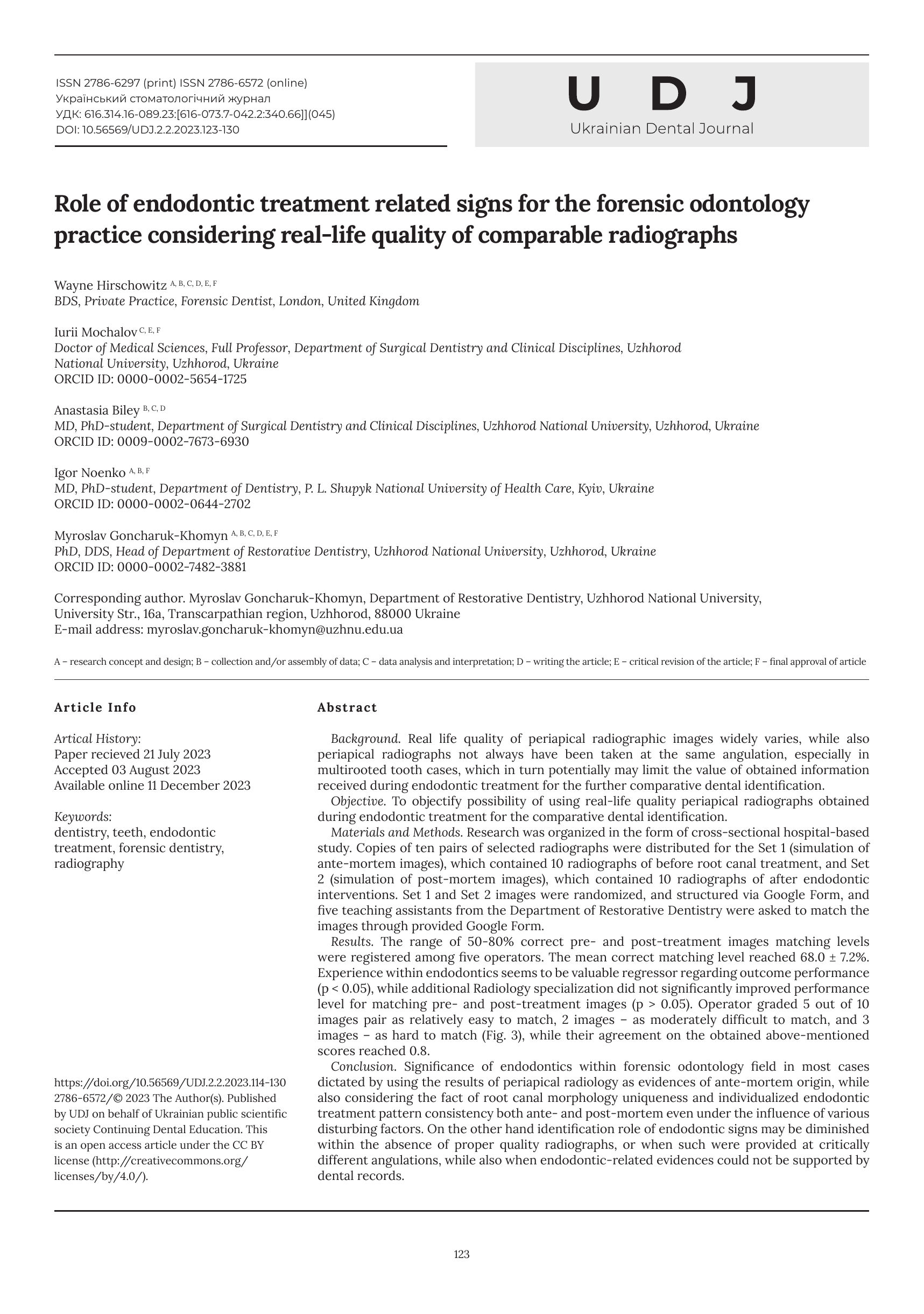Role of endodontic treatment related signs for the forensic odontology practice considering real-life quality of comparable radiographs
DOI:
https://doi.org/10.56569/UDJ.2.2.2023.123-130Keywords:
dentistry, teeth, endodontic treatment, forensic dentistry, radiographyAbstract
Background. Real life quality of periapical radiographic images widely varies, while also periapical radiographs not always have been taken at the same angulation, especially in multirooted tooth cases, which in turn potentially may limit the value of obtained information received during endodontic treatment for the further comparative dental identification.
Objective. To objectify possibility of using real-life quality periapical radiographs obtained during endodontic treatment for the comparative dental identification.
Materials and Methods. Research was organized in the form of cross-sectional hospital-based study. Copies of ten pairs of selected radiographs were distributed for the Set 1 (simulation of ante-mortem images), which contained 10 radiographs of before root canal treatment, and Set 2 (simulation of post-mortem images), which contained 10 radiographs of after endodontic interventions. Set 1 and Set 2 images were randomized, and structured via Google Form, and five teaching assistants from the Department of Restorative Dentistry were asked to match the images through provided Google Form.
Results. The range of 50-80% correct pre- and post-treatment images matching levels were registered among five operators. The mean correct matching level reached 68.0 ± 7.2%. Experience within endodontics seems to be valuable regressor regarding outcome performance (p < 0.05), while additional Radiology specialization did not significantly improved performance level for matching pre- and post-treatment images (p > 0.05). Operator graded 5 out of 10 images pair as relatively easy to match, 2 images – as moderately difficult to match, and 3 images – as hard to match (Fig. 3), while their agreement on the obtained above-mentioned scores reached 0.8.
Conclusion. Significance of endodontics within forensic odontology field in most cases dictated by using the results of periapical radiology as evidences of ante-mortem origin, while also considering the fact of root canal morphology uniqueness and individualized endodontic treatment pattern consistency both ante- and post-mortem even under the influence of various disturbing factors. On the other hand identification role of endodontic signs may be diminished within the absence of proper quality radiographs, or when such were provided at critically different angulations, while also when endodontic-related evidences could not be supported by dental records.
References
Weisman MI. Endodontics—A Key To Identification In Forensic Dentistry: Report Of A Case. Aus Endod Newsl. 1996;22(3):9-12. doi: https://doi.org/10.1111/j.1747-4477.1996.tb00548.x
de Andrade JG, Carrijo GA, Loureiro C, Ribeiro AP, Rodrigues GW, de Castilho Jacinto R. Endodontic images as a forensic identification: A literature review. Res Soc Dev. 2021;10(8): e16310816994. doi: https://doi.org/10.33448/rsd-v10i8.16994
Spyropoulos ND, Liakakoy P. The use of periapical x-rays in the identification of a corpse. Hell Stomatol Chron. 1990;34(2):151-6. PMID: 2130043
Silva RF, Franco A, Picoli FF, Nunes FG, Estrela C. Dental identification through endodontic radiographic records: A case report. Acta Stomatologica Croat. 2014;48(2):147-150. PMID: 27688359
Silva RF, Franco A, Mendes SD, Picoli FF, Nunes FG, Estrela C. Identifying murder victims with endodontic radiographs. J Forensic Dent Sci. 2016;8(3):167-170. doi: https://doi.org/10.4103/0975-1475.195112
Shamim T. The relationship of forensic odontology with various dental specialties in the articles published in the Journal of Forensic odonto-stomatology from 2005 to 2012. Indian J Dent. 2015;6(2):75-80. doi: https://doi.org/10.4103/0975-962X.155888
Sushmitha YR, Yelapure M, Hegde MN, Devadiga D, Reddy U. Knowledge and awareness of role of endodontics in Forensic Odontology-A questionnaire based survey among postgraduate students. J Evol Med Dent Sci. 2020 Feb 3;9(5):262-5. doi: https://doi.org/10.14260/jemds/2020/59
Balagopal S. The Application and Cogency of Dental Restorations and Endodontics in Forensic Odontology. J Oper Dent Endod. 2022;6(2):51-2. doi: https://doi.org/10.5005/jp-journals-10047-0117. PMID: 27350699
Khalid K, Yousif S, Satti A. Discrimination potential of root canal treated tooth in forensic dentistry. J Forensic Odontostomatol. 2016;34(1):19-26.
Majumder H, Sharma AS, Jadhav AK, Deshpande SS. Role Of Endodontics In Forensic Odontology-A Review. J Pharm Negat Results. 2023;13:7138-42. doi: https://doi.org/10.47750/pnr.2022.13.S09.841
Patel A, Parekh V, Kinariwala N, Johnson A, Gupta MS. Forensic identification of endodontically treated teeth after heat-induced alterations: An in vitro study. Eur Endod J. 2020;5(3):271-276. doi: https://doi.org/10.14744/eej.2020.37450
Jethi N, Arora KS. Forensic endodontics and national identity programs in India. Indian J Dent Res. 2020;31(4):662-5. doi: https://doi.org/10.4103/ijdr.IJDR_187_19
Sharda K, Jindal V, Chhabra A. Effect of high temperature on composite as post endodontic restoration in forensic analysis-an in vitro study. Dent J Adv Stud. 2014;2(02):084-90. doi: https://doi.org/10.1055/s-0038-1671991
Khirtika SG, Ramesh S. Effect of high temperature on crowns as post-endodontic restoration in forensic analysis: an in vitro study. J Adv Pharm Edu Res 2017;7(3):240-243.
Rajendran A. Effects of Elevated Temperature in Forensic Endodontics: A Comparative Review. J Forensic Dent Sci. 2020;12(3):201-5.
Savio C, Merlati G, Danesino P, Fassina G, Menghini P. Radiographic evaluation of teeth subjected to high temperatures: Experimental study to aid identification processes. Forensic Sci Int. 2006;158(2-3):108-16. doi: https://doi.org/10.1016/j.forsciint.2005.05.003
Fernandes AP, Jacometti V, da Silva RH. Radiographic changes in endodontically treated teeth submitted to drowning and burial simulations: is it a useful tool in forensic investigation?. J Forensic Odontostomatol. 2021;39(1):9-15. PMID: 34057153
Bonavilla JD, Bush MA, Bush PJ, Pantera EA. Identification of incinerated root canal filling materials after exposure to high heat incineration. J Forensic Sci. 2008;53(2):412-8. doi: https://doi.org/10.1111/j.1556-4029.2007.00653.x
Bansode PV, Pathal SD, Wavdhane MB. Application of endodontic imaging modalities in forensic personal identification: a review. IOSR J Dent Med Sci. 2018;17(4):45-8.
Berketa JW, Sims C, Rahmat RA. The utilization of small amounts of residual endodontic material for dental identification. J Forensic Odontostomatol. 2019;37(1):63-65. PMID: 31187744
Ahmed HM. Endodontics and forensic personal identification: An update. Eur J Gen Dent. 2017;6(01):5-8. doi: https://doi.org/10.4103/2278-9626.198593
Mishalov VD, Goncharuk-Khomyn MY, Voichenko VV, Brkic H, Kostenko SB, Vyun VV, Brekhlichuk PP. Forensic dental identification in complicated fractured skull conditions: case report with adapted algorithm for image comparison. J Forensic Odontostomatol. 2021;39(2):45-57.
Van Der Meer DT, Brumit PC, Schrader BA, Dove SB, Senn DR. Root morphology and anatomical patterns in forensic dental identification: a comparison of computer‐aided identification with traditional forensic dental identification. J Forensic Sci. 2010;55(6):1499-503. doi: https://doi.org/10.1111/j.1556-4029.2010.01492.x
Forrest AS, Wu HY. Endodontic imaging as an aid to forensic personal identification. Aust Endod J. 2010;36(2):87-94. doi: https://doi.org/10.1111/j.1747-4477.2010.00242.x
Jain A, Chaudhuri S. Forensic Endodontics. Med Clin Res. 2019;4(2):1-2.
Penaloza TY, Karkhanis S, Kvaal SI, Nurul F, Kanagasingam S, Franklin D, Vasudavan S, Kruger E, Tennant M. Application of the Kvaal method for adult dental age estimation using Cone Beam Computed Tomography (CBCT). J Forensic Leg Med. 2016;44:178-82. doi: https://doi.org/10.1016/j.jflm.2016.10.013
Bjørk MB, Kvaal SI. CT and MR imaging used in age estimation: a systematic review. J Forensic Odontostomatol. 2018;36(1):14-25. PMID: 29864026
Goncharuk-Khomyn M. Modification of Dental Age Estimation Technique among Children from Transcarpathian Region. J Int Dent Med Res. 2017;10(3):851-5.
Higgins D, Austin JJ. Teeth as a source of DNA for forensic identification of human remains: a review. Sci Justice. 2013;53(4):433-41. doi: https://doi.org/10.1016/j.scijus.2013.06.001
Pinchi V, Torricelli F, Nutini AL, Conti M, Iozzi S, Norelli GA. Techniques of dental DNA extraction: Some operative experiences. Forensic Sci Int. 2011;204(1-3):111-4. doi: https://doi.org/10.1016/j.forsciint.2010.05.010
Corte-Real AT, Anjos MJ, Andrade L, Carvalho M, Serra A, Bento AM, Oliveira C, Batista L, Corte-Real F, Vieira DN, Gamero JJ. Genetic identification in endodontic treated tooth root. Forensic Sci Int. 2008;1(1):457-8. doi: https://doi.org/10.1016/j.fsigss.2007.10.094
Zaheen U, Nadeem K, Ramzan S, Mirza M, Khan HA. Use of Endodontic Imaging Modalities in Forensic Identifications. Pak J Med Health Sci. 2023;17(01):302-303. doi: https://doi.org/10.53350/pjmhs2023171302

Downloads
Published
Issue
Section
Categories
License
Copyright (c) 2023 The Author(s)

This work is licensed under a Creative Commons Attribution 4.0 International License.








